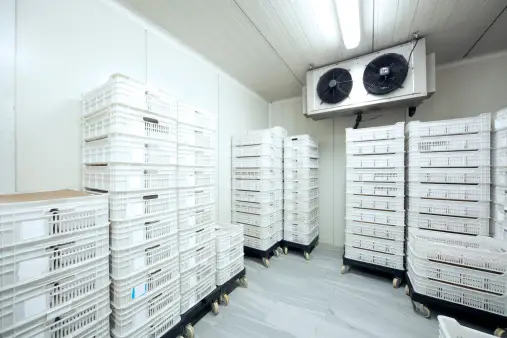
From the vibrant produce aisles of supermarkets to the bustling kitchens of restaurants, a silent hero works tirelessly behind the scenes: the commercial cold room. These temperature-controlled chambers are essential for countless industries, ensuring the safe and optimal storage of everything from food and pharmaceuticals to chemicals and flowers. But what exactly are commercial cold rooms, and how do they work their magic?
The Core Function: Maintaining the Chill
At its heart, a commercial cold room is a large, insulated space designed to maintain a specific, consistent temperature.
This temperature range can vary depending on the intended use, with chilled rooms typically operating between 0°C and 10°C (ideal for fruits, vegetables, and beverages) and frozen rooms maintaining temperatures as low as -28°C (perfect for ice cream, meat, and seafood).
Building Blocks of a Cold Room:
Insulation: The key to maintaining a consistent temperature is top-notch insulation. Walls, floors, and ceilings are typically constructed with thick panels made of polyurethane foam or other insulating materials.
Doors: Heavy-duty, insulated doors minimize heat transfer when opened and closed, crucial for maintaining energy efficiency
Refrigeration System: The heart of the cooling system, this unit pumps refrigerant through coils, extracting heat from the air within the room. Different types of refrigeration systems are available depending on the size and temperature requirements of the cold room.
Control System: A monitoring system with sensors ensures the temperature remains within the desired range, automatically adjusting the refrigeration system as needed.
Beyond the Basics: Customization and Features
Commercial cold rooms are not one-size-fits-all solutions. They come in various sizes, from small walk-in units to large industrial facilities, and can be customized with features like:
Shelving and storage systems: Optimized for efficient organization and accessibility of goods.
Flooring: Specialized non-slip floors for safety and easy cleaning.
Lighting: LED lights minimize heat generation and energy consumption.
Humidity control: Crucial for certain products like flowers and pharmaceuticals.
The Benefits of Chilled and Frozen Storage:
Commercial cold rooms offer several advantages:
Extended Shelf Life: Perishable items stay fresh and safe for longer, reducing spoilage and waste.
Quality Preservation: Consistent temperatures maintain the quality, taste, and nutritional value of products.
Compliance with Regulations: Many industries have strict temperature regulations for food and pharmaceutical storage, which cold rooms help meet.
Improved Inventory Management: Efficient storage and organization facilitate better stock control.
Energy Efficiency: Modern cold rooms are designed with energy-saving features, reducing operating costs.
From Restaurants to Pharmacies: Diverse Applications:
Commercial cold rooms find use in a wide range of industries, including:
Foodservice: Restaurants, grocery stores, caterers, and food processors all rely on cold rooms to store ingredients, prepared meals, and beverages.
Pharmaceutical: Cold rooms are essential for storing temperature-sensitive medicines and vaccines.
Floral: Florists use cold rooms to preserve the freshness and beauty of their flowers.
Chemical and Manufacturing: Cold rooms are used to store and process various chemicals and materials that require specific temperatures.
In conclusion, commercial cold room are the unsung heroes of many industries, playing a critical role in preserving food, ensuring safety, and maintaining product quality. As technology advances, cold rooms will continue to evolve, offering even greater efficiency, sustainability, and customization to meet the diverse needs of businesses around the world.
